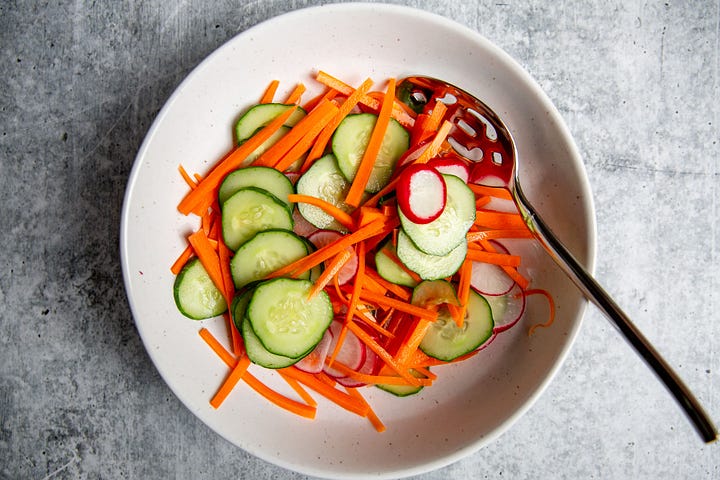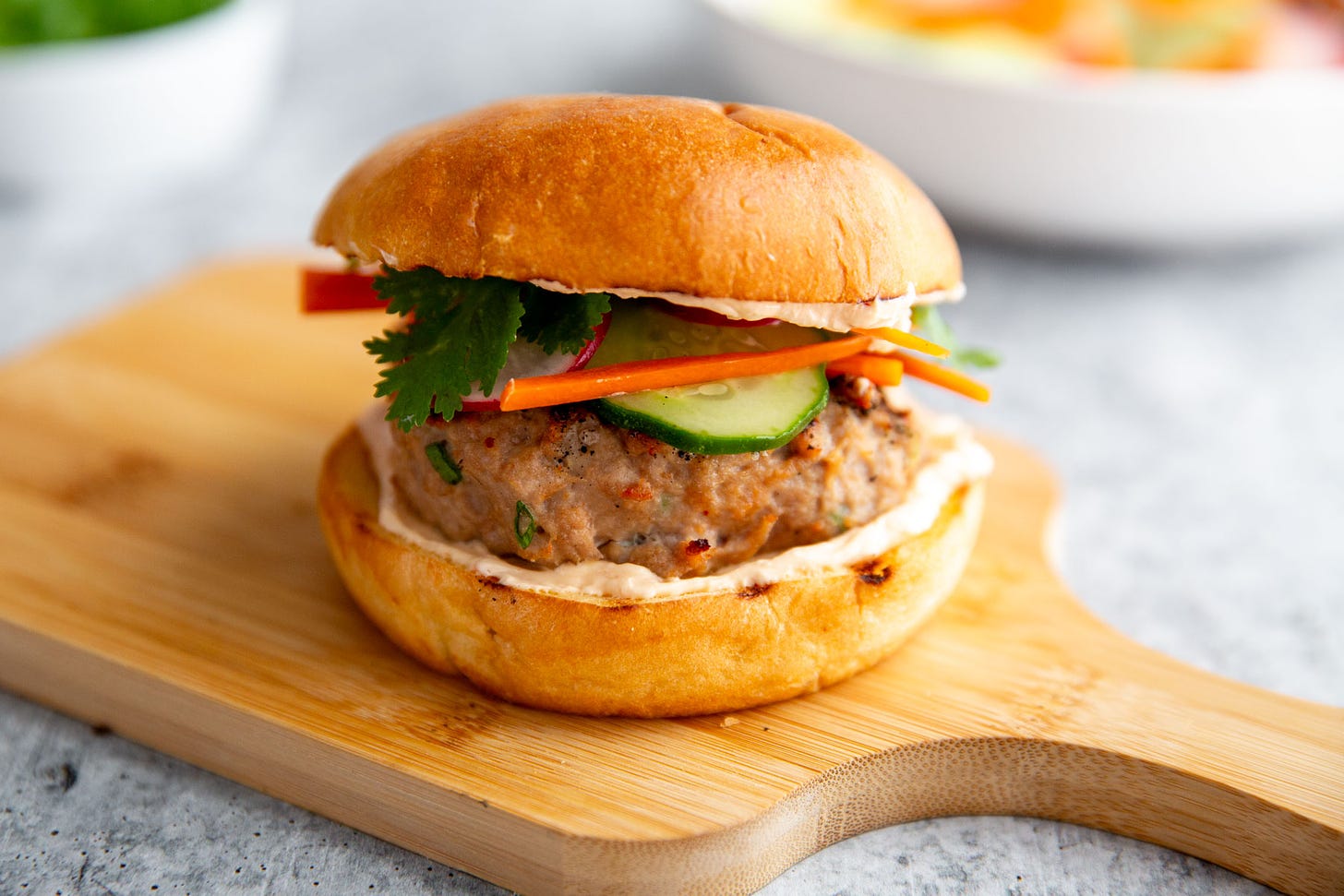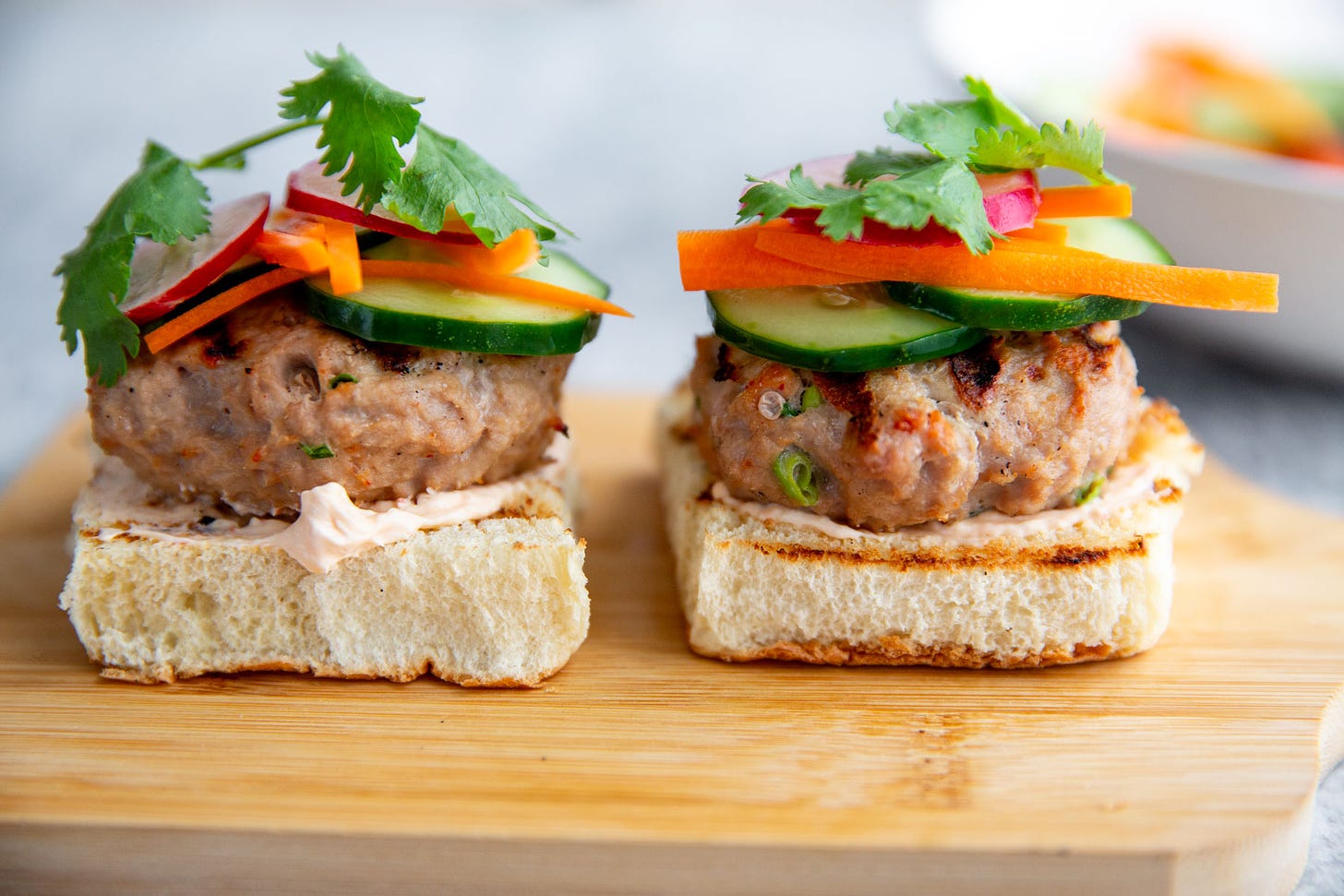Happy Friday, friends! These juicy, umami-laced turkey (or pork) burgers get piled with crunchy pickled vegetables and a creamy-spicy sriracha cream cheese spread. They’re loaded with texture and can be served as burgers or sliders (which my kids love). The recipe was actually inspired by a pretty horrible airport meal, proving that inspiration doesn’t always come from the uplifting moments—sometimes it’s the hard stuff (or the not-very-delicious stuff) that can spark creativity and change. Speaking of hard stuff, I had my eyes opened last week when I attended the Beyond Delicious: Transforming the Future of Food Conference, which examined the current state of the food industry and where it’s going. The conference was incredibly inspiring, but it was also a wake-up call.
Today is the last day of my back-to-school sale. Get 20% off a paid subscription or gift subscription here:
While I love exploring how food connects us to our minds, bodies, and spirits (and will continue to do so), the food industry at large is connected to a much wider web that involves land management, financial equity, climate change, human rights, and more. These aren’t small topics—they’re incredibly nuanced and complicated—and I can barely scratch the surface in a single newsletter. However, I wanted to share some of the topics discussed, because if we can’t see the web we’re in, then there’s no chance of changing it. Our food choices have larger implications than just our health and personal well-being (but there’s hope!!). I hope you’ll stick with me.
How did we get here?
While people have been farming on American soils for millennia, the current food industry had its roots with European settlers. It was a system built out of colonialism (you can hear more about the history of US land management in my recent podcast episode with Liz Carlisle). At the Beyond Delicious conference, Indigenous chef Sean Sherman defined colonialism as “extraction for profit.” This system of extraction and land domination is still the operating force behind the food industry today. In Carlisle’s book, Healing Grounds: Climate, Justice and the Deep Roots of Regenerative Farming, she states:
It doesn’t take a historian to recognize that the brutalization of Indigenous people was a fundamental part of US ‘settlement.’ But we tend to mentally separate that legacy from what is currently happening on the land. That disconnect allows us to denounce racial oppression while simultaneously supporting agricultural systems that were built on it. In fact, both human atrocities and environmental destruction stemmed from European societies’ effort to remake the world in their image.
Slave labor was integral to the development of the US agricultural system, and discrimination continued well after the Civil War. According to Carlisle, “Following emancipation, the nation’s agricultural labor would be passed on to slave descendants, then immigrants whose legal status was carefully manipulated to approximate a similarly oppressive condition.”
Throughout the first half of the Twentieth century, Black farmers faced an “onslaught of financial racism” and were routinely denied loans or were violently forced off their land. A 2022 study from the American Economic Association shows that land loss due to discriminatory USDA lending policies, among other factors, is a contributor to the current racial wealth gap in the US. As food activist Tunde Way explained at the conference, the way that funds are allocated and resources are distributed (in other words, our financial system) continues to play a key role in maintaining the food industry’s operating force of oppression. Today it’s estimated that just 1.4% of American farmers identify as Black.
Agribusiness
The vertical integration and monopolization of agribusiness over the past few decades has created an even larger imbalance of power. As
, food writer and producer of the upcoming documentary, Food and Country, explained at the conference, this raises a serious national security issue (for instance, there are only four major meatpacking conglomerates, and if just one of the packers had to shut down, there would be massive country-wide shortages). The current model also still relies on low-wage immigrant workers, often who don’t make a living wage. As FarmworkerJustice.org states:About 30% of farmworker families live below the poverty line, according to the most recent National Agricultural Workers Survey (NAWS). That’s almost double the poverty rate of the U.S. as a whole (15.9% in 2012).
Reichl estimated that only 7% of farmers in the US actually make a living wage from farming, and it’s increasingly hard for small farmers to succeed. A recent New York Times article revealed that suicide rates among American farmers is three and a half times higher than that of the general population.
Environmental implications
The affects of the food industry extend beyond just inequity and oppression. According to conference speaker Roy Steiner, senior vice president for the Food Initiative at The Rockefeller Foundation, the industrial food industry accounts for 25-33% of total greenhouse gas emissions. Agribusiness has become increasingly reliant upon fertilizers and pesticides, and this is further damaging soil health and its ability to store carbon (for more information about the environmental impacts of the industrial farming system, check out the podcast with Liz Carlisle).
Healthy food is (not) a human right
Government farm subsidies are designed to assist farmers but largely go to commodity crops, not food. According to the National Institutes of Health, the cost of “healthier” foods—vegetables, fruits and dairy—is twice the cost of packaged and processed foods (soda, sweets, snacks). As urban farming advocate Karen Washington explained during the conference, this has contributed to food apartheid, where low income families don’t have access to and can’t afford fresh, nutrient dense foods (but are often surrounded by plenty of cheap, industrialized foods).
This bodes the question, should access to nutritious foods be a human right? In 2021, the US was the only country among 180 countries that voted against food as a human right in a United Nations vote.
Food is a political issue
The unfortunate reality is that many of our food purchases unintentionally support and perpetuate the current system of extraction and oppression. Unless you’re off the grid or homesteading, it’s simply built into the fabric of American food. As Washington stated at the conference, “the food system doesn’t need to be fixed. It needs to change.”
argued that we can no longer ignore the fact that food is a political issue, and that widespread change needs to start at the level of the government. She stated, “The cheap food we have is enormously expensive. You don’t vote with your dollars. You vote with your votes.”There is hope
While all of this can start to feel overwhelming (and we’re barely scratching the surface), there’s also plenty of hope. People across the country (including those who are linked in this essay) are working hard to change the system. As science and technology expands, we’re better able to understand the repercussions—for the environment, for our communities, and for our health—of the industrialized food model. New technology is also beginning to show the nutritional benefits of growing food with low chemical intervention, which will hopefully help inspire change. According to Steiner, The Rockefeller Foundation is using new technology to study the nutritional value of foods grown regeneratively (in support of the soil) versus foods grown using high amounts of fertilizers and pesticides. While in the past scientists have only been able to measure a small sliver of the molecules in food (approximately 150 molecules), the new technology allows them to measure approximately 20,000 molecules, and the results are showing that food grown regeneratively has a much higher nutritive value (the data will be released at the end of the year).
The point of this essay isn’t to add stress, but to to provide awareness. It’s not easy to look at the history (and current state) of our food system. However, as soil scientist Laura Lengnick explained at the conference, we need to be willing to examine and accept this dark history with honesty instead of denying it, and that only in going there—with courage and vulnerability—can we begin to move beyond the current paradigms and create something new.
Small steps
Feeding our families isn’t easy. It requires time and money, of which we all have varying amounts. We can’t all afford to buy organically or shop locally, or even to cook regularly, and that’s okay—it’s the system we live in. However, we can start thinking more deeply about where our food comes from and who helped bring it to our tables. We can talk about these things with our people, with our kids. We can express gratitude for the food on our plates, for the farmers and workers whose efforts allowed us the privilege of a meal, and for the earth for nurturing and sustaining us. We can begin to examine our values and our choices. And we can give ourselves grace. We’re all in this together.
If it feels right, we can also start to make small shifts, such as the ones below:
We can stop taking food for granted.
We can deepen our connection with the natural world, shifting from an extractive perspective to a reciprocal perspective.
We can grow food in gardens or windowsills.
We can be more conscious of our purchases, supporting local growers and/or businesses that grow food ethically and pay their workers fairly, when we can afford to do so.
We can put our votes towards a more equitable, fair food system, where farmers and farm workers are paid fairly, and where the health of the land and soil (which is essential for growing nutritious food) is better supported.
I’ll leave you with one last quote from Lengnick, from her book, Resilient Agriculture, “Remember that privilege is power and use yours for good.”
If you know of an organization or a human working to change the food system for the better and would like to share, please do so here.
Banh Mi Inspired Turkey Burgers
There’s no easy (or non-awkward) way to segue into this recipe. However, please know that the choices you make regarding food are completely yours. This is a nonjudgemental space. You get to decide what foods are right for you and your family. I’d love for us as a community to be supportive; to be open to listening, and sharing, and growing together. One of the best ways I know how to do that is around the dinner table. So here we go. Let’s share a meal.
The inspiration for the burgers came about after a very disappointing meal at Denver International Airport. I ordered the banh mi turkey burger at Root Down restaurant, which came with pickled vegetables and sriracha cream cheese. The concept sounded so good, but burger was bland and dry—it tasted, well, like airport food (that being said, I love the flagship Root Down restaurant in downtown Denver). The concept was there, but the flavors were not.


When we got home I was still craving the burger that I had thought I was going to get, so I set about recreating it. After a few tests, the result was just what I was hoping for—a juicy garlic and ginger-laced burger (you can use turkey or pork), balanced by crunchy, bright pickled vegetables, and a creamy, spicy sriracha cream cheese spread. You can make regular burgers or sliders on dinner rolls, which my kids love (because small food is always more fun to eat).
Make the recipe yours. Give thanks. And remember, that pleasure can be its own form of resistance.
Get 20% off a paid subscription or gift subscription here (the offer ends tomorrow!):
Keep reading with a 7-day free trial
Subscribe to Mind, Body, Spirit, FOOD to keep reading this post and get 7 days of free access to the full post archives.







